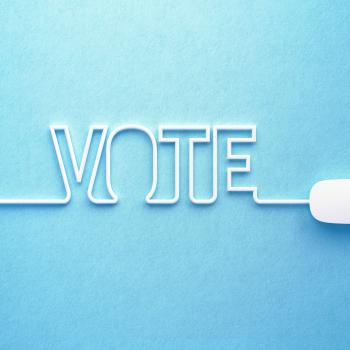Vote for Me! Making Presidential Commercials Using Avatars

- Preview |
- Standards |
- Resources & Preparation |
- Instructional Plan |
- Related Resources |
- Comments
Overview
In this lesson each student researches the political platform and the campaign slogan of a past president. Then the student creates a 45-60 second script for a commercial for the election of the president. Using this script the student creates the commercial using Voki, an online web tool in which a student can create an avatar to resemble the presidential candidate. The student can record his own voice or use text to speech option to add the script. The final product can be linked to or embedded in a website.
Featured Resources
- Voki in the Classroom: This resource is used for producing the commercials created by students.
From Theory to Practice
During any political campaign, students are exposed to numerous political advertisements. They hear campaign messages on radio, view them on billboards, watch them on television, and read them on the Internet. Without a doubt students realize these ads are aimed to persuade people to vote for the featured candidate, but rarely do students think about the fact these ads reflect the political platform of the candidate. Using past political platforms from presidential elections as primary sources of information provides what Morgan describes as, “valuable opportunities for interdisciplinary learning and critical thinking in all fields of study” (69).
Furthermore, Semali suggests that students need to be taught new literacies because of the media-rich environment in which we live. This lesson addresses media literacy, which he defines as “the ability to access, experience, evaluate, and produce media products.” The end result of this lesson will be a commercial produced using an online web tool.
Further Reading
Common Core Standards
This resource has been aligned to the Common Core State Standards for states in which they have been adopted. If a state does not appear in the drop-down, CCSS alignments are forthcoming.
State Standards
This lesson has been aligned to standards in the following states. If a state does not appear in the drop-down, standard alignments are not currently available for that state.
NCTE/IRA National Standards for the English Language Arts
- 1. Students read a wide range of print and nonprint texts to build an understanding of texts, of themselves, and of the cultures of the United States and the world; to acquire new information; to respond to the needs and demands of society and the workplace; and for personal fulfillment. Among these texts are fiction and nonfiction, classic and contemporary works.
- 3. Students apply a wide range of strategies to comprehend, interpret, evaluate, and appreciate texts. They draw on their prior experience, their interactions with other readers and writers, their knowledge of word meaning and of other texts, their word identification strategies, and their understanding of textual features (e.g., sound-letter correspondence, sentence structure, context, graphics).
- 4. Students adjust their use of spoken, written, and visual language (e.g., conventions, style, vocabulary) to communicate effectively with a variety of audiences and for different purposes.
- 5. Students employ a wide range of strategies as they write and use different writing process elements appropriately to communicate with different audiences for a variety of purposes.
- 6. Students apply knowledge of language structure, language conventions (e.g., spelling and punctuation), media techniques, figurative language, and genre to create, critique, and discuss print and nonprint texts.
- 7. Students conduct research on issues and interests by generating ideas and questions, and by posing problems. They gather, evaluate, and synthesize data from a variety of sources (e.g., print and nonprint texts, artifacts, people) to communicate their discoveries in ways that suit their purpose and audience.
- 8. Students use a variety of technological and information resources (e.g., libraries, databases, computer networks, video) to gather and synthesize information and to create and communicate knowledge.
- 11. Students participate as knowledgeable, reflective, creative, and critical members of a variety of literacy communities.
- 12. Students use spoken, written, and visual language to accomplish their own purposes (e.g., for learning, enjoyment, persuasion, and the exchange of information).
Materials and Technology
- Classroom computer with projection capabilities and speakers
- Computers with Internet capabilities and headphones (optional microphones)
- Print sources from the Suggested Print Materials printout
Printouts
Websites
For a minimal charge this website provides one hundred twenty student accounts per educator. The teacher can assign students to classes, post class projects, give individual student feedback, and hide or show student names with the projects. Additionally, when the project includes writing, the students can submit their written assignments (up to 500 characters) directly through the website.
Preparation
- Sign up for an account at Voki in the Classroom. Create classes and assign students to the classes. Post the assignment at Voki in the Classroom so that students will be able to see the due dates from any Internet connected computer.
- Create a class site to link the websites for students to use. You can also use the wiki to link to each student’s end product. If this is not possible, make one copy per student of Selected Websites.
- Create a sample Voki or use this sample from Barack Obama’s election in 2008.
- Make one copy per student of the Voki Rubric, Voki Preparation and Voki Instructions. Make enough copies of The Issues in order for each student to complete this printout for all commercials done by their classmates.
- Using websites listed above, choose a presidential commercial you would like to show for Session One.
- Reserve the school’s computer lab or library for two class periods, one for research and one for creating the Voki. If students are to record their own voices for their commercials, check that both headphones and microphones are available for use. If the text to speech option will be used, only headphones are necessary.
- Contact the school librarian to make available to your students books from the Suggested Print Materials printout, as well as to find more print materials on specific elections.
Student Objectives
Students will:
- identify the main points of a political platform.
- create a script for a political commercial for a president.
- use Voki as a media tool to present that commercial.
Session One
- Choose a commercial from Presidential Campaigns and Candidates or from The Living Room Candidate for a past election. Tell the students to think about the message as they listen. Project the commercial on the board or screen.
- After viewing discuss what issues this candidate is addressing. For example, if viewing George Bush’s 2000 ad from Presidential Campaigns and Candidates, discuss the following points
- What did Bush do for the state of Texas as governor?
- Why are his past accomplishments important?
- What can the viewer infer from this commercial are Bush’s concerns?
- What is the campaign slogan from the commercial?
- Also, encourage the students to contribute facts they know about the president for additional background information.
- Discuss the following ideas:
- Ask the class how a presidential candidate determines what his issues are.
- Discuss the idea of party platform.
- Use The American Presidency Project website to show the party platform for the candidate you selected.
- Compare the platform to the commercial.
- Explain to the class that now they will become producers and create commercials for past presidents.
- After logging into Voki in the Classroom, show the students where on this website they can find the instructions for the project. Go through the assignment, rubric, and expectations.
- Play the Voki sample or the one you have created.
- Hand out the Voki Rubric and play the sample again for the students to evaluate.
- Hand out Voki Preparation printout.
- Assign each student (or allow students to choose) a president to research so that the class is ready to research in the next session. Have students write down their candidates on the Voki Preparation printout. Tell students to bring this form with them for sessions two and three.
Session Two
- Direct the class to the wiki for the selected research websites or hand out the printout Selected Websites.
- Have the Suggested Print Materials as well as any other books on past elections available for the class to use.
- Instruct students to complete the Voki Preparation printout.
- As students work, check for the following:
- Time on task as that is a category for the rubric.
- Students are finding at least three issues for their candidates.
- For most presidents, students should be able to find a campaign slogan.
- Assign students to write a script for their commercial that lasts 75-90 seconds. You can have the students directly submit their scripts through the Voki website or have them write out the scripts.
Session Three
- Before this session occurs, make sure students have completed their scripts (or allow time for them to finish).
- Have the students find their presidents at The White House: Presidents so that they will have images to match to their avatars.
- Hand out the Voki Instructions printout.
- Open a second window or tab to model for the students how to login to Voki.
- Model for the students how to create avatars to resemble their presidents.
- Depending on which option you have chosen, model for the students how to use either voice recording or text to speech options.
- Model for students how to change the background and discuss what type of background would be appropriate.
- Allow students time to work on their Voki commercials.
- As students are working, ask the students questions about their candidates’ political platforms.
- Pair students together to use the Voki Rubric to evaluate each other’s commercials.
- Remind students that their commercials must be completed before the next session.
Session Four
- Hand out The Issues printout and instruct students to complete these as they view each other’s commercials.
- Have each student share his/her Voki.
- After each commercial allow time for students to ask questions. For example, they might want to know if the president achieved his goals. This discussion might lead to what students research next.
- After all commercials have been shown, have a mock election between all the presidents represented.
- After the vote, allow students to explain their rationale behind their votes, via a discussion or a short paragraph.
Extensions
- After more research, have students write a paragraph comparing the president’s political platform to what he achieved during his time in office. Students can also address why the president did not achieve his platform goals.
- The American Presidency Project includes farewell and inaugural addresses from some presidents. Students could compare and contrast these in formal essays, among other ways.
- Have students create another commercial for an opposing candidate.
- Have students try the Presidential Campaign Slogan quiz at Infoplease.
- If funds are not available for Voki in the Classroom, students over age thirteen can sign up for their own Voki accounts and share the links for their media products on the class wiki. For those under thirteen, students could present their commercials to the class as if they were the presidential candidates.
- If you used Voki in the Classroom, you still might want to post links for the commercials on the class wiki for parents and other community members to enjoy.
- Show the commercials to other classes in the school and hold a mock election between all the presidents represented.
Student Assessment / Reflections
- Use the Voki Rubric to evaluate the students' commercials.
- Evaluate the Voki Preparation printout, written scripts, and The Issues printout for completion.
- Question the students as they work on their Vokis about the political platform for their presidents.

Add new comment